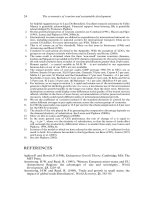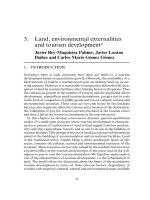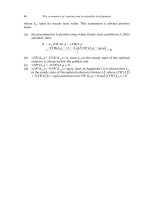THE ECONOMICS OF MONEY,BANKING, AND FINANCIAL MARKETS 312
Bạn đang xem bản rút gọn của tài liệu. Xem và tải ngay bản đầy đủ của tài liệu tại đây (38.51 KB, 1 trang )
280
PA R T I I I
Financial Institutions
At the same time, the oil exporters were depositing huge sums in banks and
as a result the banks were lending not only to the oil-importing countries but also
to the oil-exporting countries, because the latter had large oil reserves and
seemed like good credit risks. The banks underestimated the indebtedness of
these countries the total amount these countries had borrowed from banks
and, as a result, were severely punished in the early 1980s when the recession hit
and real interest rates increased significantly. With Argentina, Brazil, Mexico, and
Peru threatening to default on their loans, the banks had two choices: to reschedule their loans and make more loans to these countries (to enable them to pay
the interest on the debt), or to declare these countries in default and acknowledge large losses on their balance sheets. The banks chose to make more loans,
because in many cases the losses would have been large enough to destroy them.
Today, the LDC debt is no longer a significant threat to the international banking
system, because of other arrangements as well. In recent years, for example, a variety of debt conversion schemes have been proposed to alleviate the debt service
obligations of the major indebted LDCs. There are three main forms of debt conversion: debt-debt swaps (where banks holding the debt of one LDC exchange it for
the debt of another LDC), debt-currency swaps (where the debt denominated in
foreign currency is converted into domestic currency), and debt-equity swaps
(where the debt is converted into the equity of public and private domestic enterprises). The main impetus of all these debt conversion schemes has been the recognition that the true value of the sovereign debt is well below its face value.
As a result of their lending experience in Latin America, the Big Six have
withdrawn from certain countries and focused more of their international activities
in the United States. Moreover, the international activities of Canadian banking organizations are now regulated, primarily by the Office of the Superintendent of
Financial Institutions Canada (OSFI), created in 1987 to succeed two separate regulatory bodies: the Inspector General of Banks and the Department of Insurance. In
particular, in 1991, the OSFI asked the chartered banks to set up special reserves in
the amount of 35% 45% of their exposure to a number of LDCs.
Foreign Banks
in Canada
The growth in international trade not only has encouraged Canadian banks to
open offices overseas but also has encouraged foreign banks to establish offices
in Canada. Foreign banks have been extremely successful in Canada. Over the
past 20 years, since the 1981 revision to the Bank Act, globally prominent foreign
banks have set up and expanded banking subsidiaries in Canada. Foreign banks
are a highly fragmented group and currently hold about 8% of total Canadian
bank assets, with HSBC Bank Canada (the former Hongkong and Shanghai
Banking Corp.) enjoying a national market share of over 3%. It should be noted,
however, that these institutions target specific groups, achieving a higher representation within their target groups than their national share would suggest. For
example, HSBC, the largest of the Schedule II banks, enjoys a strong presence
and success in the Chinese communities of British Columbia and Ontario.
Foreign banks may enter the Canadian financial services industry as either
Schedule II or Schedule III banks. As already noted, Schedule II banks don t have to
be widely held if small. If, however, their equity capital exceeds $1 billion, then
at least 35% of it must be widely held. In the case that their equity capital exceeds
$5 billion, then the same widely held ownership rule applies as for Schedule I banks.
The major difference between Schedule II and Schedule III banks is that Schedule III
banks can branch directly into Canada, following authorization by the Minister of
Finance, whereas Schedule II banks can add branches to their initial branch only with









